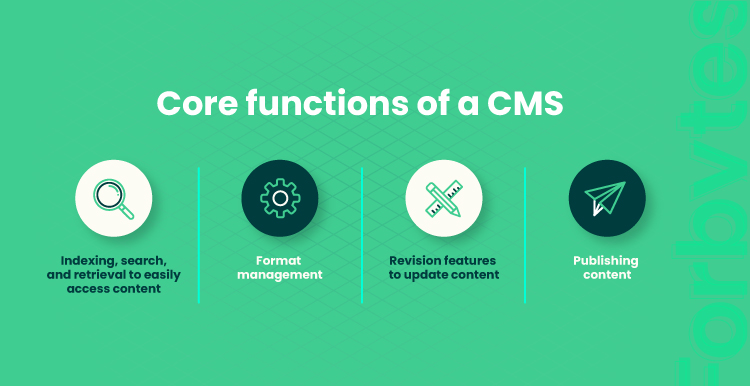The best content management system (CMS) is the one that integrates your workflow, communications, and content marketing tools. But to opt for a standard CMS or create a custom CMS? That is a question for a business that plans to maximize its marketing efforts.
You’ve found a good on-shelf CSM, being convinced it will work perfectly for your marketing strategy. But the reality is different. This CMS solution lacks custom functionalities and fails to fit unique workflows, processes, and content structures specific to your organization.
A custom CMS is a more efficient, secure, and user-friendly platform tailored to your business requirements. Plus, custom SEO features and tools allow for tracking and measuring your content performance effectively.
But creating a custom CMS isn’t an easy task. First, you should invest time and resources to build a quality solution. Second, you should hire developers who can assist you with this task. Finally, another dilemma is where to start and what to consider to benefit from your custom CMS.
That’s why we’re here to help and inspire you to create a tailored content management system and succeed in marketing strategy. From first steps to vital considerations, we’ll pave the way for building a custom CMS. Just continue reading.
What Is a CMS?
Content is one of the most important parts of your online marketing strategy. If you want to streamline your company’s website and enhance your content quality, an embedded content management system can help you along the way. A CMS is essentially software that allows for the management and publication of digital content. A good CMS should not only include SEO-friendly features but be custom-built to suit user needs and allow them to create a community around the content.
There are over 73 million live websites that use CMSes on the Internet as of March 2022. The most vivid example would be WordPress which neatly bundles all the necessary functions needed to run a website. WordPress leads the pack, powering 43.2% of all websites, with a content management system market share of 62.8%. Other popular CMS platforms include Shopify, Wix, Squarespace, Joomla, Drupal, Adobe Systems, PrestaShop, Google Systems, and Webflow.
A CMS usually consists of a front-end web interface, a back-end database that contains indexed content, and software that determines how to render the website based on user input. It provides an environment for the development, maintenance, and deployment of web pages and their associated content, resulting in a tightly organized site with minimal internal server-side (backend) code.
Before you decide whether you want to build a custom CMS, look at what steps you will have to take and the knowledge you will have to possess to do a good job.
How to Build a Custom CMS
There are many CMSes available, each with its suite of features. A lot of business owners aren’t sure which features are important and which ones aren’t. That’s why they decide to create a custom CMS to meet their specific business needs.
But developing a scalable, affordable, and secure content management system that is easy to install, use, manage, update, and grow and that can meet an organization’s needs is a complex undertaking. If you’re in this boat, you’ve come to the right place. Read on to find out what your first steps should be towards your custom CMS.
Step 1: Conceptualization
If you are operating a blog or have the intent to create one, you, first of all, should have a good idea of what your perfect content management system should do and the processes your website undergoes. For this, you will have to take the following steps:
- Analyze the company’s existing content architecture and management strategies, and content types used to determine the optimal way to curate content for the organization’s webpage cohesively and easily.
- Define what requirements for content and what purposes your custom CMS solution will fulfill. Again, this also largely depends on the type of content you’re about to create and publish.
- Describe the features of your custom CMS. For instance, you may need a custom CMS to include custom-built templates, templates personalized according to users’ needs, SEO tools, widgets, etc.
- Identify the user roles, or tasks, and the categories for which content will be written. Keep in mind that your CMS users will be uniquely qualified in their roles as content authors, content editors, or other roles.
Step 2: Planning
In addition to the elegance of well-designed and informative content, implementing a content management strategy means those in charge of the website can update it efficiently, without spending a lot of time and resources changing HTML code and without worrying whether or not their content is published. Part of what makes a CMS so valuable (if it’s developed in the right way) is the fact that it’s future-proof. This means that despite any changes your website might need to make in the future, it will still allow all users to perform their functions uninterruptible.
So, what can you do to make it so? The secret lies in accurate planning. A custom CMS is one of the most important digital marketing tools at a website’s disposal. But without careful planning, it can quickly become a headache instead of an effective marketing tool.
Take care of the following tasks:
- Figure out content management strategies: content lifecycle workflows, content refresh rates, user functions, and access, saving/deleting content, and regulatory observance.
- Define the technical requirements for the CMS and build a software requirements specification.
- Select a proper platform or technology stack for custom CMS development.
- Outline the CMS creation roadmap. This includes determining the time necessary for development, budget, and target KPIs.

Step 3: Design
Most content management systems have an editorial component that can be completely customized, from font choice to color styling and navigation layout. Important features such as publishing workflows, content editing, and website analytics need to be tested before the full site is tested to ensure a high-quality experience.
UX in e-commerce is much more than a pretty experience on the front end. It’s about crafting experiences with the users in mind. Developers need to build a custom CMS that empowers content creators and facilitates their work. This is why it’s important to understand why design matters and how to bring it into your custom CMS.
- Ensure designers take care of organization and categorization which contributes to the ease and effectiveness of content search.
- Create specific workflows that each content type can accommodate to ease content management workflows (creation, approval, publishing).
- Take care of CMS prototypes, personas, conducting usability tests, and other processes related to creating or updating a user or website design.
Step 4: Development
CMS development is a long-term investment that will ultimately provide your website with the flexibility to keep up with the rapid changes in the market. Take into consideration the following approach for your CMS implementation:
- Create a platform-based CMS: We recommend using this alternative if a typical web CMS can handle your content management needs.
- Create a custom CMS from scratch: If you want to design a flexible, scalable, multi-purpose solution for your specific website needs, try this option.
Step 5: Testing
Developing an in-house CMS can be a daunting task, but it’s even tougher to ensure it works as planned. This is most evident during the first few days after launch when configuration errors are most likely to occur. Unfortunately, these errors typically lead to lost productivity and downstream iteration. This process can be avoided by following a few steps in the custom CMS development lifecycle.
Testing is the process of finding out whether the software performs consistently, whether it is achieving its design goals, and whether it is stable. If you’re in charge of enterprise-level content management, you need to test your custom CMS solution and make sure it will be available and useful to your users. You also need to be prepared for QA. After all, your custom CMS is an integral part of your company’s strategy for reach and scale, and it must be functioning properly.
To make sure your newly created custom CMS solution works well, just follow these four simple steps:
- Set up a QA team.
- Integrate multilingual support.
- Test content at the system’s source code level.
- Check performance.
Step 6: After-Launch Support
As deadlines approach, the pressure to build and launch a custom CMS increases. But keep in mind that once you launch it, your job isn’t done yet. You need to ensure mission-critical integration: ensure smooth processes by providing the framework of support to users.
For many companies, the process of implementing a new after-launch content management system can be overwhelming as they find themselves spending lots of time and energy on misguided efforts that could have been avoided.
Here’s what you do to make sure your custom CMS solution will be a success in the long run:
- Create professional documentation about an industry-standard CMS system and provide it as supplemental information for CMS users.
- Conduct training on content creation, approval, publication, and updating for CMS users.
- Gather feedback from your users, and then decide on whether or not to implement relevant changes to your custom CMS platform.
Key Considerations When Building a Custom CMS
Many business owners wonder how they can build a custom content management system (CMS) of their own. But, this often poses a dilemma. The variety and complexity of CMSes can dissuade people, but a lack of knowledge about what to look for can lead to an expensive and protracted project.
Here are some helpful things to consider before embarking upon building your custom CMS.
Security
When it comes to managing a website, most individuals will defer security to a reliable hosting company. They trust that their website’s server infrastructure and web applications will be protected and that they won’t suffer immensely if the website’s database gets hacked. However, it is often much easier to prevent a website from being hacked in the first place. For example, if you build your own CMS, you can implement security measures to guard against attack vectors before hackers have the opportunity to exploit system loopholes.
Architecting and deploying a custom content management system that can withstand the coming years of attacks and keep serving up quality content powerfully is extremely important for companies. After all, getting your readers to stick around without experiencing a site performance issue is one of the key missions of your content plan. And if you don’t place the security of a CMS platform at the core of your development efforts, you’ll end up missing out on many readers and leads later.
Over time, security features can be added and strengthened. The more astute developers of the CMSes put in place defenses against hackers, and the wider CMS community learns how to mitigate the security issues, the lower barriers to entry become. This means the industry is moving forward to be user-centric.
Maintainability
Often, using a CMS requires some level of maintainability to keep your site up and running. However, many websites are still hard to change and update and visitors have to deal with broken code.
The perfect solution would be hosting and maintaining the codebase of a custom-built content management system. This way you can keep your blog integration process to a minimum so the blog team can focus on writing, which is the core of any content marketing.
Customize your CMS so it can scale with your needs and reach a wider audience.
SEO
Managing your website’s content is one of the toughest tasks. You want to get good SEO, attract potential customers, and prevent bots from scraping your website. Traditional CMSes take way too long to build or are painful to use. An SEO-built CMS is a powerful tool to boost your online visibility, attract customers, and prevent bot scraping on your website.
As the web evolves, creating a custom CMS with a good website architecture is more important than ever. The old-school strict models are not capable of keeping up with modern SEO value-adds. So you need to leverage today’s technologies while ensuring future-proof functionality.
If you’re building a website or blog, you need to create an SEO-friendly custom content management system to be able to sift your content through the dizzying array of options on the Internet. With a good CMS platform at hand, monthly, you can add new content, bump your SEO, or give your website a design refresh. Your website will keep evolving and growing as you learn your business, so it makes sense to also plan out how you want to manage it and add systems to facilitate all of that.
Need Help with Building a Custom CMS?
Many businesses, from small start-ups to busy corporations, are now using their customized content management system. They create, publish, and manage all their digitized information, ranging from sales collateral and online content to electronic invoices and receipts.
Developing your own custom CMS is hard. This is why most developers don’t do it. But if you have a vision in your head that you don’t want to leave behind and even if it takes a lot of hard work and resources, you should do it.
Need help building your custom CMS? Contact us and we’ll gladly help you out!

Our Engineers
Can Help
Are you ready to discover all benefits of running a business in the digital era?

Our Engineers
Can Help
Are you ready to discover all benefits of running a business in the digital era?








